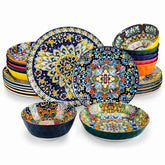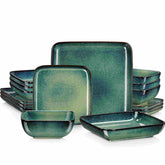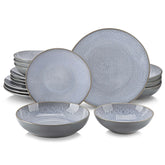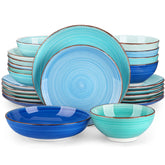Family Health: How the Right Cereal Bowl Can Improve Your Eating Habits
Navigation
- The Psychology of Eating: Size Perception and Portion Control
- Choosing the Right Cereal Bowl for Healthier Breakfast Portions
- Large Cereal Bowls: Not Just About Size
- Design and Color Concerns for Appetite Appeal
- Practical Tips for Using Cereal Bowls to Manage Family Meals
Maintaining a healthy diet and portion control are crucial for the overall health and well-being of an individual. A balanced diet supplies the body with all the nutrients required for proper functioning, while portion control helps one take the right amount of food to meet the energy requirements without taking excess food. It may come as a surprise that something as simple as a cereal bowl can be instrumental in maintaining healthy eating habits. Thus, the proper bowl size and design can help people control their portions and make them more conscious about what they eat, which is beneficial for their health.
The Psychology of Eating: Size Perception and Portion Control
Portion size plays a significant role in how we judge the amount of food we consume. Research indicates that using larger plates and bowls often leads people to serve themselves more food than necessary, all without their conscious realization. This is called portion distortion, where larger dishware makes the food portions look smaller, and people end up taking more food on their plates or bowls. Research by Dr. Brian Wansink, a food psychology expert, has revealed that people who use large bowls consume between 16-31% more than those who use small bowls. This unconscious behavior can lead to overeating and weight gain over time. Thus, the size of the bowl is not only a question of design – it determines how much we eat.
Choosing the Right Cereal Bowl for Healthier Breakfast Portions
1. Standard vs. Large Cereal Bowls: Impact on Serving Sizes
When it comes to portion control, the type of cereal bowl used is very important. Most standard cereal bowls have a capacity of 1.5 cups, which is ideal for serving most breakfast cereals. Small bowls, for instance, can only accommodate up to 1 or 2 cups, while the larger bowls can accommodate up to 3 cups or more, thus making people pour more servings without noticing it. This variation in size could result in the consumption of several hundred extra calories, especially when paired with high-calorie toppings like nuts or sugar.
2. Controlling Portion Sizes for Different Family Members
Choosing an appropriately sized cereal bowl can significantly aid families in managing portion sizes effectively. Different age groups require varying food and portions, and utilizing cereal bowls of assorted sizes can cater to this nutritional diversity. For instance, children may require small bowls that are in proportion to their small stomachs, while the rest of the family may use normal bowls to avoid overeating. This small change in the type of dishware used can ensure that each family member gets the right portion size without the urge to take more food.
3. How a Well-Designed Cereal Bowl Reduces Portion Size?
An intelligently designed cereal bowl can facilitate portion control, helping individuals prevent overindulgence. Bowls that are slightly curved or narrow towards the bottom can make the portions look larger, even if they are not. This design gives the impression that the bowl is full to the brim, thus informing the brain that the portion is adequate. Also, bowls that have portion control indicators on the side can be useful since they can help people avoid overeating by reminding them of the recommended portions.
Large Cereal Bowls: Not Just About Size
1. The Ambiguity of Large Cereal Bowls
Large cereal bowls are usually considered to be a bad idea because they lead to overeating, but they can be useful if applied correctly. For instance, large bowls can lead to the incorporation of a range of healthy foods by providing a larger area for the addition of healthy ingredients such as fruits, seeds, and yogurt. Instead of filling the bowl with cereal, people can divide it, dedicating one half to cereal and the other to fruits or vegetables, promoting balanced meals. This method not only helps in achieving the right proportions of the meal but also brings variety and nutrients to the meal.
2. Healthy Eating Tips for Large Cereal Bowls
Large bowls don't inevitably lead to overeating; strategic use can actually support healthy eating habits. One of the best tips is to pour cereal up to the middle of the bowl and the second half with fruits such as berries or banana slices. This strategy lowers the overall consumption of cereal while at the same time raising the consumption of fiber-rich, low-calorie foods. Likewise, the inclusion of such items as puffed rice or air-popped popcorn can make the meal bulky without necessarily being rich in calories, thus making people feel full while consuming a healthy meal.
3. Visually Enhancing Fullness with Large Bowls
To make large bowls look more filling without adding more calories, one should consider adding foods with low calories but high volume. For instance, incorporating berries occupies space and provides natural sweetness along with fiber. Other choices include vegetables or unsweetened puffed grains, which will help fill the stomach without adding too many calories. Through the use of color contrast and volume, people can prepare meals that are appealing to the eye and, at the same time, healthy portion sizes.
Design and Color Concerns for Appetite Appeal
1. Color Psychology and Appetite Regulation
The shape and color of a cereal bowl can have a profound impact on the way people eat. Color psychology research suggests certain colors can stimulate hunger, while others may promote a feeling of fullness. For example, warm colors such as red, orange, and yellow are associated with hunger and are often used in restaurants. On the other hand, cool colors such as blue and green are known to decrease appetite and slow down the rate at which people eat. Selecting cereal bowls in colors such as blue may help people to eat slowly and, therefore, avoid overeating.
2. Design Features that Reassure Mindful Eating
Besides color, there are other design aspects of cereal bowls that can encourage slower eating habits. Ceramic bowls with rough or irregular bases and non-standard shapes can help people pay attention to what they are eating instead of mindless eating. Also, bowls with small diameters or high rims can help in measuring small quantities of food more easily. Such minor design features can be very effective in encouraging people to make better food choices.
Practical Tips for Using Cereal Bowls to Manage Family Meals
1. Teaching Children about Portion Sizes with Bowls
Cereal bowls are also very useful for parents who want to explain to their children what portion control means. By involving children in selecting their bowls and discussing the significance of portion control, parents can foster the development of healthy eating habits. For example, by guiding children to put appropriate amounts of cereal, milk, and fruits into their bowls, parents can ensure their children enjoy balanced meals.
2. Fun Family Activities to Encourage Healthy Eating
It is easier to make healthy eating fun for the whole family when creativity is used. An activity that can help in creating enthusiasm for portion control is the use of decorated individual cereal bowls. Allowing children to personalize their bowls through painting or sticker application may increase their eagerness to consume healthier fare. Furthermore, families can experiment with a variety of ingredients and toppings to craft delicious and nutritious breakfast bowls that appeal to children.
With the help of cereal bowls, people and families can control their portions, encourage the consumption of healthy foods, and develop proper eating habits for a lifetime.













